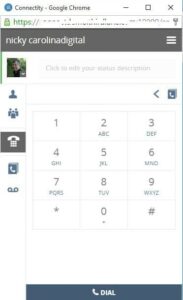 We’ve all heard of soft skills, software, softball, and of course, everyone’s favorite: soft serve ice cream. But softphones? For many people, this term is not part of their vocabulary — yet.
We’ve all heard of soft skills, software, softball, and of course, everyone’s favorite: soft serve ice cream. But softphones? For many people, this term is not part of their vocabulary — yet.
For starters, no, this is not some kind of Nerf-inspired phone that people can use to make calls one minute, and kick across the room the next (although the inventors out there might want to take a run at this, because it would be a bestseller).
Rather, softphones are software apps that let people make and receive calls on the cloud phone system network across various devices, such as their desktop computer, laptop, tablet or smartphone. Here are 5 reasons why your business — and your users — will fall in love with softphones, and wonder how you ever survived in the pre-softphone era:
1. Affordably and Quickly Add Users
With a conventional landline phone system, adding lines to support new hires is costly, time-consuming, and tedious — especially if technicians must come on-site and lay cable and configure the PBX. It can be several days or even weeks before lines are added.
Softphones eliminate this pain and suffering. New hires simply head to a special URL in their web browser, and they are all set to make and receive calls, as well as access all cloud phone system features such as chat and SMS, call history, contact list, and more.
2. Support a Mobile Workforce
Because softphones are designed to work with tablets and smartphones, they are ideal for “road warriors” who spend little (or maybe virtually no) time at their desks. What’s more, employees have full control over various calling options such as mute, hold, transfer, add call, speaker, and more.
3. Transfer Live Calls
What happens when an employee is speaking to a customer (or any other important party) on a conventional phone, but is on the way out and needs to switch to their smartphone? They need to ask the customer to call them back, or they need to call the customer back. Either way, it’s disruptive and can lead to frustrated customers — and lost sales.
Softphones eliminate this customer experience gap by enabling employees to transfer live calls between devices. For example, sales reps can answer a call at their desk, seamlessly transfer it over to their smartphone as they make their way out of the office, and then seamlessly transfer the call again to their car’s Bluetooth system to continue the conversation without creating a disruption causing frustration.
4. Lower Total Cost of Ownership
Because softphones are virtual, there is no risk that they will become obsolete and need to be replaced. When an updated version is available, employees (or IT staff on their behalf) simply download the latest version.
5. Enhanced Privacy
While employees like the flexibility of being able to use a smartphone for work purposes, they don’t like the idea of having their name/number show up on call display. What’s more, it can be off-putting to some customers who don’t recognize who is calling — and therefore don’t answer the call.
With softphones, employees maintain the same identity when making/receiving calls as they do in the office, which means that the business name and number show up on the call display. This is more private and also more professional.
Learn More
At carolinadigitalphone.com, at NO additional cost, we provide our hosted platform customers with an easy-to-use and feature-rich web browser-based softphone, in addition to our mobile apps for iOS and Android.


